Content marketing represents the gap between what brands produce and what consumers actually want.” ~ Michael Brenner.
That's enough said to let you guess the crux of the blog here.
If you think LinkedIn is just a platform for business networking and job hunting, it simply means you haven't explored the growth potential of content marketing on the platform yet. Having a professional presence on LinkedIn is just the first step. With 55% of decision-makers relying on LinkedIn content to evaluate organizations and choose brands to partner with, LinkedIn is used by 97% of B2B marketers as part of their content marketing strategy.
And if you haven't embraced LinkedIn content marketing in your strategy yet, now is the time to make that change. With this guide, you can get a comprehensive understanding of LinkedIn content marketing and some ideas to catapult your brand's LinkedIn journey.
Let's dive in!
4 Best Benefits Of LinkedIn Content Marketing
While talking about an actionable LinkedIn strategy, we believe every marketer needs one to build their brand properly. And with LinkedIn controlling almost 50% of the social media traffic that B2B blogs and websites receive, it has become as important of a content distribution channel as Facebook and Instagram.
LinkedIn content marketing provides a host of benefits that can significantly contribute to your brand-building efforts. As you develop and execute your LinkedIn content strategy, keep the below-mentioned benefits in mind to maximize your brand's growth and impact.
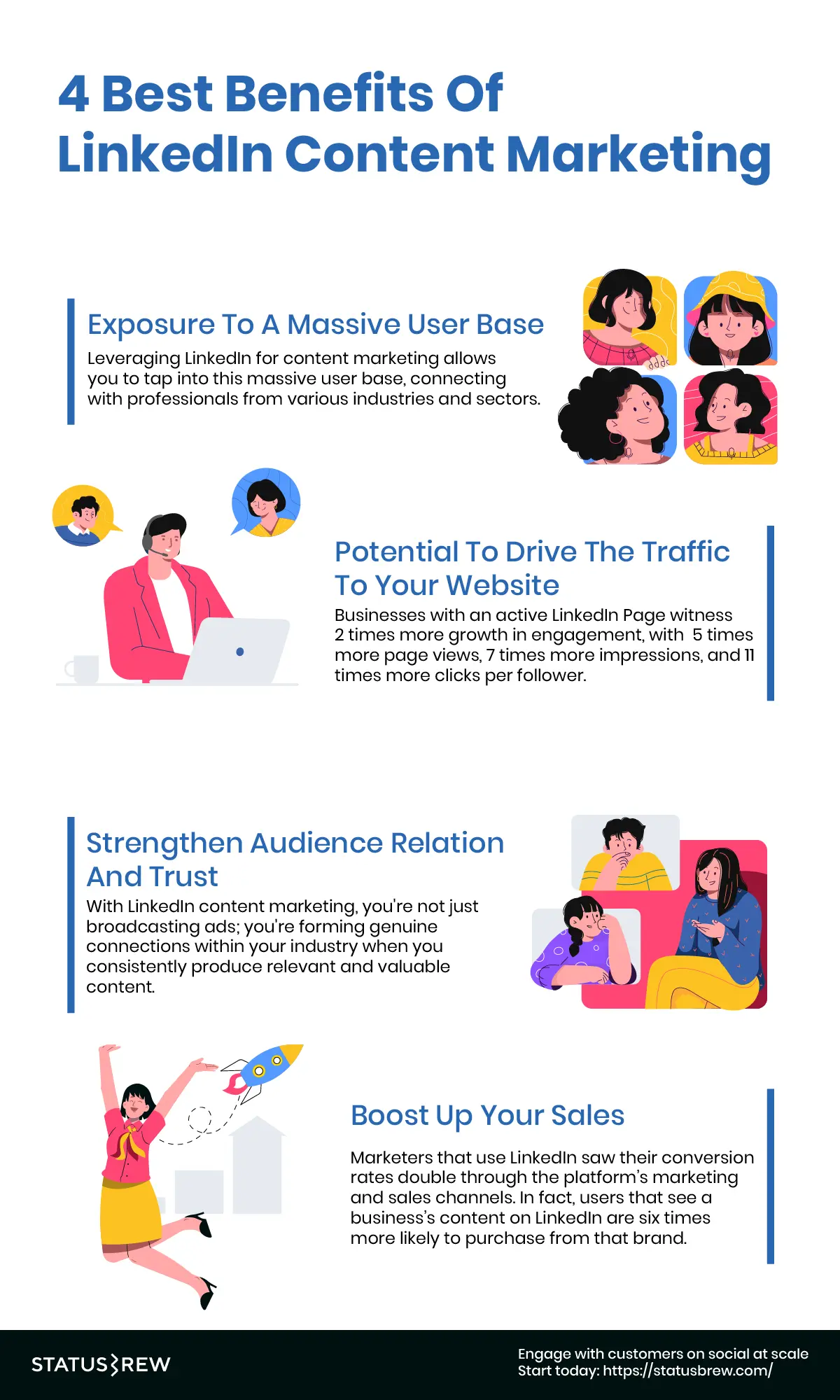
1. Exposure To A Massive User Base
LinkedIn boasts over 900 million users worldwide, making it one of the largest professional networking platforms globally. Leveraging LinkedIn for content marketing allows you to tap into this massive user base, connecting with professionals from various industries and sectors.
This exposure can be invaluable for brand building, as it means your brand's story, products, and services can reach people who might never have stumbled upon it otherwise. By consistently sharing high-quality content, you position your brand in front of a diverse and engaged audience, increasing the likelihood of your content being seen, shared, and discussed.
2. Potential To Drive The Traffic To Your Website
LinkedIn isn't just a platform for networking; it's also a powerful driver of website traffic. In fact, Businesses with an active LinkedIn Page witness 2 times more growth in engagement, with 5 times more page views, 7 times more impressions, and 11 times more clicks per follower.
When you share valuable content on LinkedIn, you can include links to your website, blog posts, landing pages, and other online assets. As users engage with your content, they're more likely to click on these links to learn more about your brand or offerings. This influx of targeted traffic can lead to increased conversions, whether it's signing up for newsletters, downloading resources, or making purchases. LinkedIn's audience is already interested in professional growth and industry insights, making them more receptive to exploring your website's content.
3. Strengthen Audience Relation And Trust
With LinkedIn content marketing, you're not just broadcasting ads; you're forming genuine connections. You demonstrate your expertise and thought leadership within your industry when you consistently produce relevant and valuable content.
This is true as 77% of content marketers opine that LinkedIn delivers the highest organic results that help establish trust with your audience, positioning your brand as a reliable source of information. Engaging with comments, messages, and discussions further enhances your brand's approachability and responsiveness. As you keep harping on these interactions, you cultivate a loyal following of individuals who see your brand as more than just a business—they see it as a valuable resource and partner in their professional journey.
4. Boost Up Your Sales
Speaking stats, LinkedIn has twice the conversion rates as other channels. Marketers that use LinkedIn saw their conversion rates double through the platform’s marketing and sales channels. In fact, users that see a business’s content on LinkedIn are six times more likely to purchase from that brand.
Hence, when you're consistently delivering value through your LinkedIn content, people start seeing you as an expert in your field, which can directly impact your sales efforts. By showcasing your brand's expertise through content, you subtly demonstrate how your products or services can solve your audience's challenges. When your audience recognizes the value you offer, they're more likely to consider your offerings when they're in need. This combination of content-driven credibility and networking potential can ultimately lead to increased sales and revenue for your brand.
8 Best Practices Of LinkedIn Content Marketing For Brand Building
1. Niche Down Your LinkedIn Audience
No strategy can start or work unless you have your audience identified. Hence, it's imperative that you identify and niche down your audience first before tailoring your content for them. Once you are done, the next pieces of the puzzle fall into place. With around 65 million decision-makers on LinkedIn as of 2023, it's about identifying those who don't just want what your brand offers but truly need it – those who are most likely to resonate with your brand's essence.
Since LinkedIn is a platform having a large network of professionals, start by considering your audience’s level of employment. For instance,
- Are they independent solopreneurs?
- Are they managers or heads of companies?
- Are they mid-level employees?
Knowing this will do half your research as the content will be different for each of these people depending on their hierarchy. Thus whoever you target, ensure you understand their requirements and pain points well enough to tailor content as per their requirements.
Pro tip: You can leverage LinkedIn insights to know about your audience, including behavior and demographics, or you can simply use polls for market research.
2. Be Clear About Your Objective And Purpose
Once you have your audience identified, think about what you want to achieve through LinkedIn content marketing. Decide whether you're:
- Seeking to boost brand awareness?
- Drive traffic to your website?
- Generate leads?
- Position yourself as a thought leader?
Crystal-clear and SMART (Specific, Measurable, Attainable, Relevant, Time-bound) objectives guide your content creation process. Chances are that “yes” is the answer to all these questions. Fair enough! This gives you clarity of what goals you want to achieve, how they fit into the realm of LinkedIn capabilities, and which has the most impact on your business.
For example, you’re a SaaS owner targeting senior-level leads. Your objective will most likely be related to your company’s revenue, traffic, awareness, efficiency, and saving time. With good market research, you will know exactly what kind of content works best for your niche and what metrics you need to monitor once your content strategy is implemented. They are:
- Conversion rate, including CRT.
- Impressions.
- Engagement rate (likes, comments, shares, etc.).
- Followers.
Remember, you cannot build your LinkedIn content marketing strategy separately. It comes as part and parcel of the rest of your marketing plan.
3. Experiment With Your Content Type
This is the most important step of all steps. Planning and experimenting with the type of content you want to put out there on LinkedIn is the stepping stone to your brand impression. Remember, no amount of shortcuts can help you out with that. It's pure market research and understanding what type of continents works best for your audience.
Luckily with LinkedIn, you can experiment a lot with your content type so that your audience doesn't get bored. There is scope for a lot of creativity, and you can start by outlining your content strategy so that you’re never unsure of what to post.
You can try out the 40/40/20 framework that is (40% expertise posts, 40% engagement posts, and 20% product, offers, and promotional posts) with the following types of content:
- Text Posts (Status Updates): Share life lessons, tips, experiences, updates, or "mini-blogs" within just (542 words for these types of posts) that resonate with your audience's professional interests.
-
Long-Form Posts (Articles): Publish in-depth articles (LinkedIn recommends 1,500-2,000 words for these pieces) that showcase your industry expertise and offer significant value.
-
Photo Posts: Though LinkedIn isn't photo-centric, incorporating relevant images can enhance engagement.
- Link Posts: Share content from external sources that complements your brand's narrative.
- Native Videos: Capitalize on the power of videos to deliver engaging content. Stick to audience preferences and relevance. In fact, 59% of executives say audiences are more likely to choose video over text on the same topic.
- Document Posts: Utilize LinkedIn's unique feature to share detailed content like whitepapers, case studies, and presentations.
- LinkedIn Newsletters: Consider turning your articles into newsletters for regular distribution and engagement.
-
LinkedIn Live: Connect with your audience through live sessions, reinforcing your brand's authority. In fact, LinkedIn Live streams generate seven times more reactions and 24 times more comments for businesses than regular videos.
-
LinkedIn Pulse: Expand your outreach by taking advantage of LinkedIn’s LinkedIn Pulse feature. With the LinkedIn Pulse feature, you can collect particular material, copy and paste your article, include a header image, cite the original publication, and distribute it to potential readers.
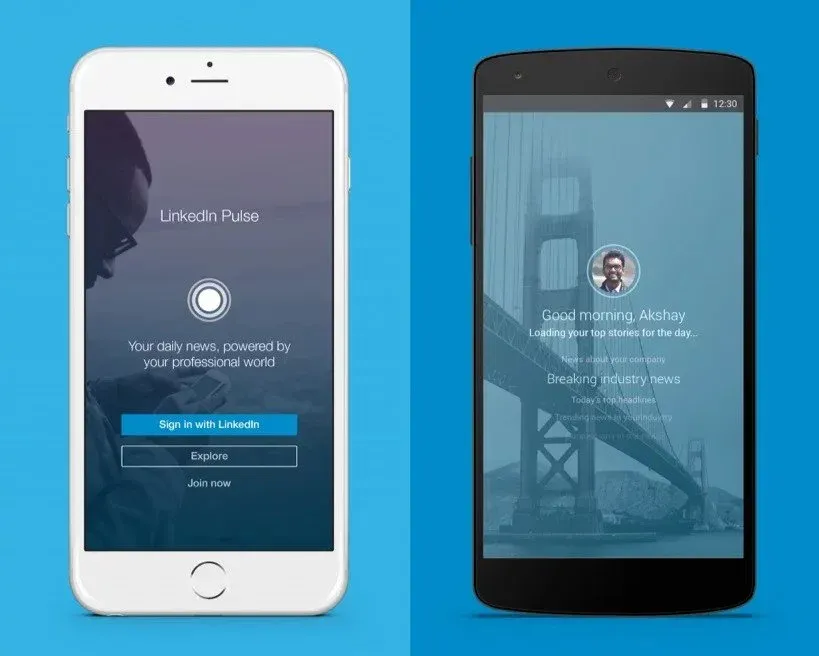
Ultimately, your content's impact hinges on its relevance, quality, and resonance with your audience. Incorporating a mix of these content types allows you to cater to diverse preferences while fostering meaningful connections on LinkedIn.
4. Know When To Post And Schedule
Crafting an effective LinkedIn content strategy involves more than just creating captivating posts; it requires strategic timing and consistency. Once you've polished your content and ensured optimal formatting, the next step is scheduling – a key aspect often overlooked in the rush to publish. You should prepare your posts well in advance, streamlining your workflow and ensuring a steady stream of valuable content.
However, LinkedIn's native platform lacks a scheduling feature. Thankfully, social media management tools like Statusbrew come to the rescue. While native scheduling on LinkedIn offers convenience, advanced tools like Statusbrew provide a range of features and analytics to optimize your posting strategy. And if you want to bulk schedule LinkedIn posts besides performing bulk actions on your posts, such as deleting, approving, or adding tags, with Statusbrew, you can do that within a matter of a few clicks!
The timing of your posts holds significant weight in maximizing engagement. Research by Statusbrew suggests that:
- Best times to post: Early morning hours starting right from 9 A.M. and afternoon hours until 5 P.M.
- Best Day To Post On LinkedIn: Wednesdays and Thursdays.
- Worst Day To Post On LinkedIn: Sunday
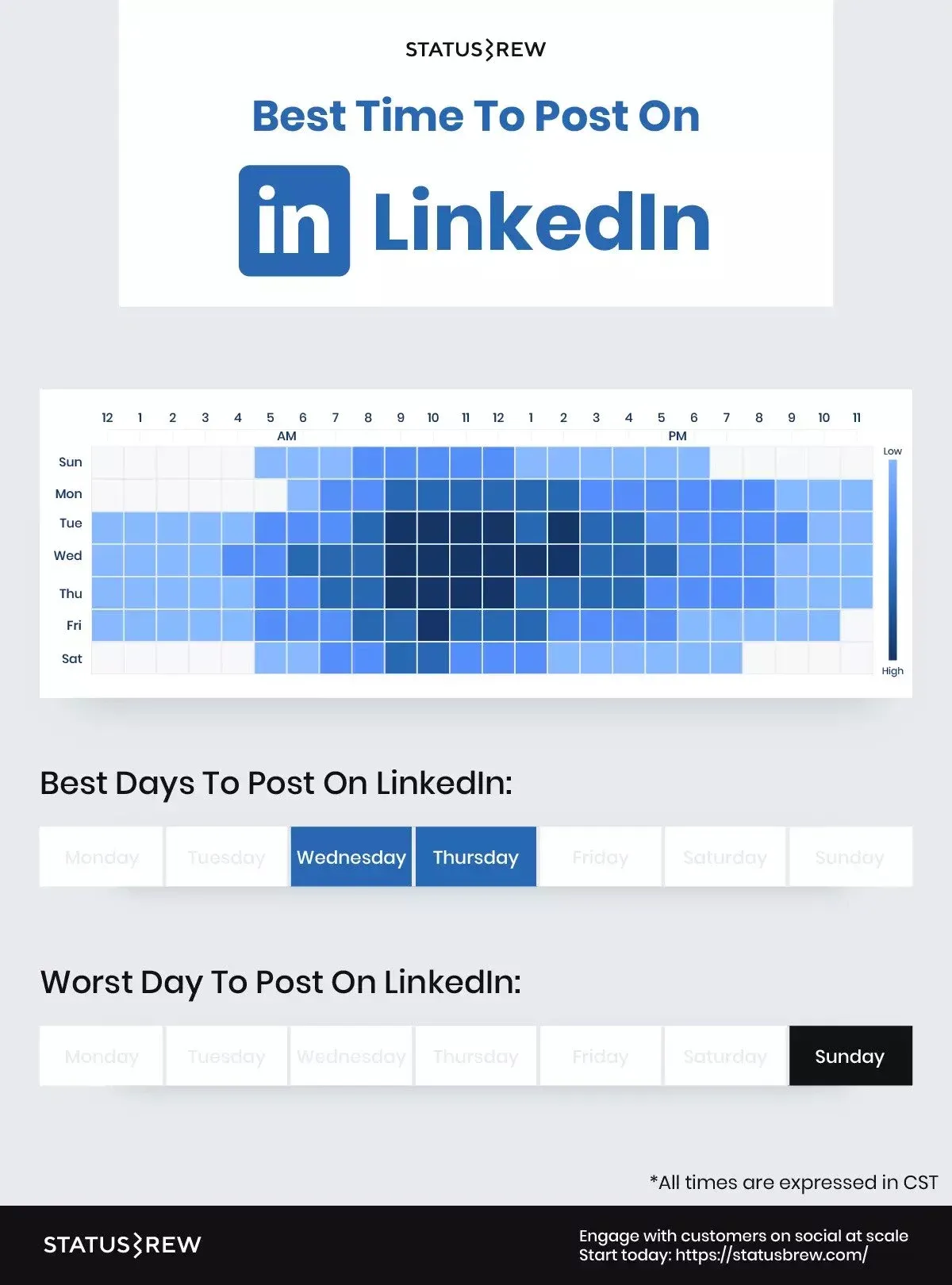
This timing aligns with professionals' active hours, increasing the likelihood of your content grabbing their attention.
We aim to ensure you can automate your posts so that content continues to go out even when no one's around to post it.
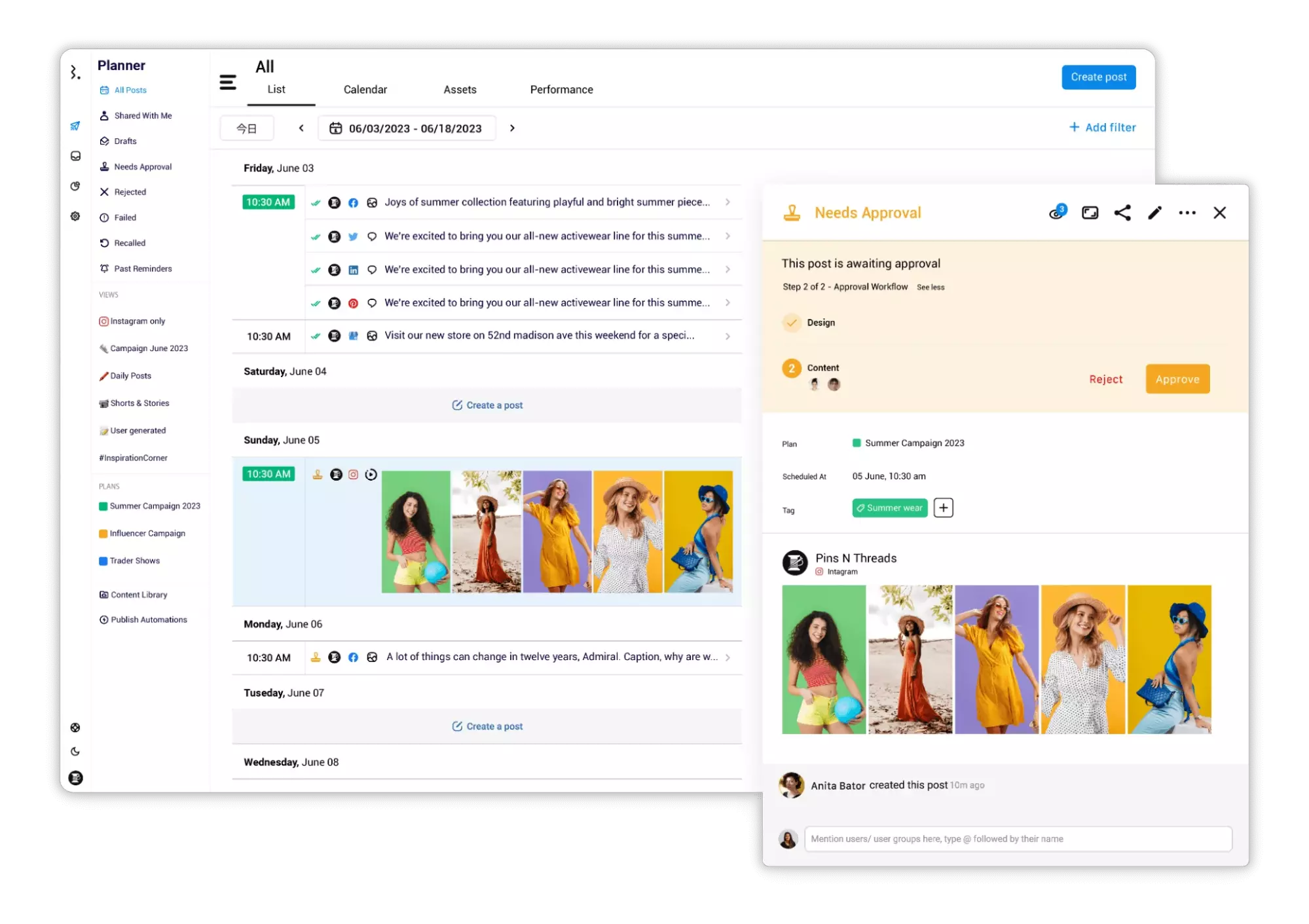
With Statusbrew, you can:
-
Auto-schedule your social feed at the best times for your audience.
-
Plan, preview, and organize your scheduled posts in your social media calendar.
-
Prepare reports with 190+ social media metrics to track your performance and share them with your team.
-
Create your own templates, and reuse or repurpose them as needed.
So what are you waiting for? Snag a FREE trial of Statusbrew today & get started!
To know more, check out our blog: The Best Times To Post On Social Media In 2023
5. Leverage LinkedIn Ads To Boost Your Organic Reach
If your goal is to achieve your objectives faster, leveraging LinkedIn ads can be your best bet. This is true as, according to 79% of content marketers, LinkedIn Ads deliver the highest results, with 75% using them.
With the power of LinkedIn ads, you can significantly amplify your content's organic reach and bolster the effectiveness of your content marketing strategy as you can reach a broader and highly targeted audience. LinkedIn ads allow you to customize your campaigns based on various parameters like demographics, job titles, industries, and more, allowing you to tap into a wider network beyond your existing followers.
You just need to select the top-performing organic content and promote it by clicking the “Boost Post” button above the post. Choose the objective and the audience, and kick-start the promotion. You can also use LinkedIn's Campaign Manager to retarget people who have already engaged with your company page or website or potential new ones.

Besides this, by leveraging LinkedIn's ad analytics, you can get valuable feedback on the performance of your content and analyze metrics such as click-through rates, impressions, and engagement to fine-tune your content strategy.
6. Interact And Engage For Better Promotion
Remember the saying, “You get what you give?" Well, in LinkedIn content marketing, this applies perfectly.
Communication on LinkedIn isn't one-dimensional. Besides your posting schedule, your engagement and interaction with your audience need to be at par as well. Remember what we stressed earlier? LinkedIn content marketing is a team effort. And by that, we mean you need to be consistent with liking, commenting on, and sharing others' content.
Create polls, use the storytelling content format, or talk about any recent development in your industry that can spark meaningful conversations. Respond to questions and comments, ask for feedback, or ask questions in return to boost the post's reach.
For instance, check out the below given LinkedIn post that talks about an industry niche in a storytelling format.
Thus consistent interaction and engagement can influence the LinkedIn algorithm, boosting your content leaps and bounds.
7. Be Genuine And Avoid Salesly Language
No sales are the best sales! While you might be wondering how that is possible, let us tell you that customers are smart. They understand what genuine pitching is and what it is for the sake of sales.
In fact, if pitched in the right way, 73% of buyers show interest in salespeople who reach out to them via LinkedIn. Hence, the goal should be promotion through an authentic and human voice than a hollow sales pitch.
Check out the below given Husbpot LinkedIn carousel post. It's non-sales, yet intelligently promotes its popular affiliate programs. Observe how they are doing it!
Remember, authenticity is paramount in LinkedIn content marketing, and steering clear of overtly sales language is essential for building genuine connections. Customers like to connect with businesses that focus on delivering informative, educational, or thought-provoking content, addressing their pain points or interests. This portrays your business in a positive light, making your audience more receptive to your recommendations and offerings.
8. Analyze Your Results And Adjust Accordingly
And last but not least, analysis is the step we can never skip when planning for LinkedIn content marketing.
Since you are putting a lot of investment into your LinkedIn content strategy, it's important to gauge what's working and what isn't for your audience. It's always a game in the long run, and you have to trial and error a lot to reach your goals.
For this, you need to keep a tab on LinkedIn Analytics or take the assistance of Statusbrew if you want to gauge your LinkedIn content marketing efforts fully. You not only get a detailed report but also customizable templates to share with your marketing team.
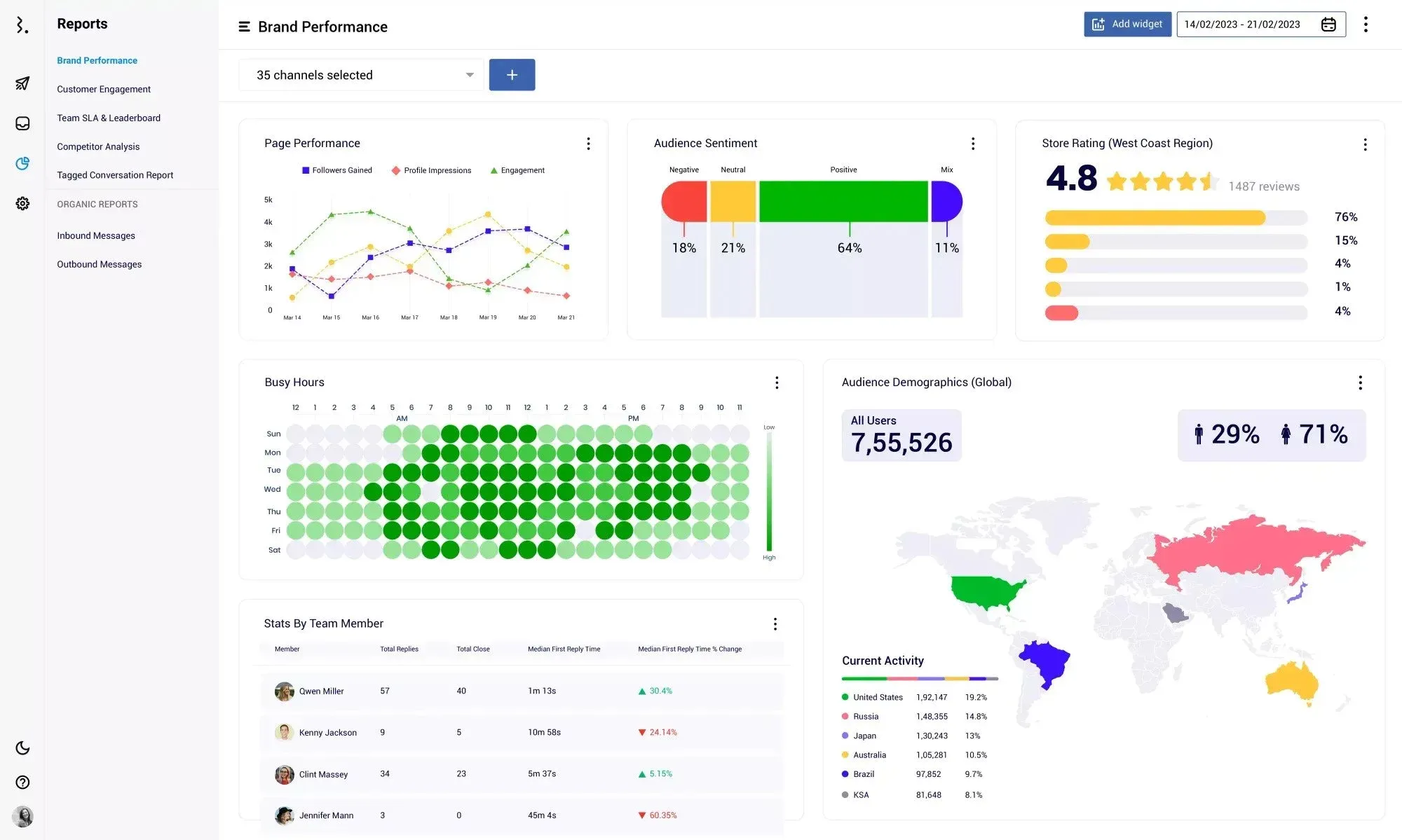
These insights will help you understand if the content strategy is effective and, based on that analysis, make changes to your strategy. Don't hesitate to experiment and iterate. If a particular content format or topic isn't performing well, adapt and try something new. Likewise, if certain strategies yield positive results, consider doubling down on them.
Ultimately, the iterative nature of content marketing demands continuous improvement. Hence harp on a content strategy that can be frequently updated and improved upon.
Beneficial read: 15 Tips To Boost Your LinkedIn Marketing In 2023
LinkedIn Content Strategy Ideas For Brand Building
Absolutely, coming up with fresh and engaging content ideas for your LinkedIn strategy is essential to keep your audience interested and connected. Here are some innovative content ideas to consider:
- Behind-the-Scenes Stories: Share glimpses of your work environment, team, and company culture. This humanizes your brand and makes you more relatable.
- Industry Trends Commentary: Offer your insights and opinions on your industry's latest trends, news, and developments. This establishes you as a thought leader.
- Storytelling: Share personal experiences, challenges you've overcome, or lessons you've learned. Authenticity goes a long way in building connections.
- Motivational Content: Share motivational quotes, stories, or insights that resonate with professionals and help them stay inspired.
- Tips and How-Tos: Provide valuable tips, tricks, and actionable advice related to your industry. Practical information is highly shareable.
- Infographics and Visual Data: Create visually appealing infographics or data visualizations that convey important industry statistics or insights.
- LinkedIn Polls: Use the polling feature to ask quick questions and gather opinions from your audience.
Dos And Don'ts Of LinkedIn Content Marketing
While we always think about finding the best practices for LinkedIn content marketing, we often miss out on the practices we should avoid during the implementation process. As mastering the art of LinkedIn content marketing requires finesse, patience, and a genuine commitment to building professional relationships, the below-mentioned dos and don'ts will help your steer clear of mistakes as you navigate the intricacies of this platform.
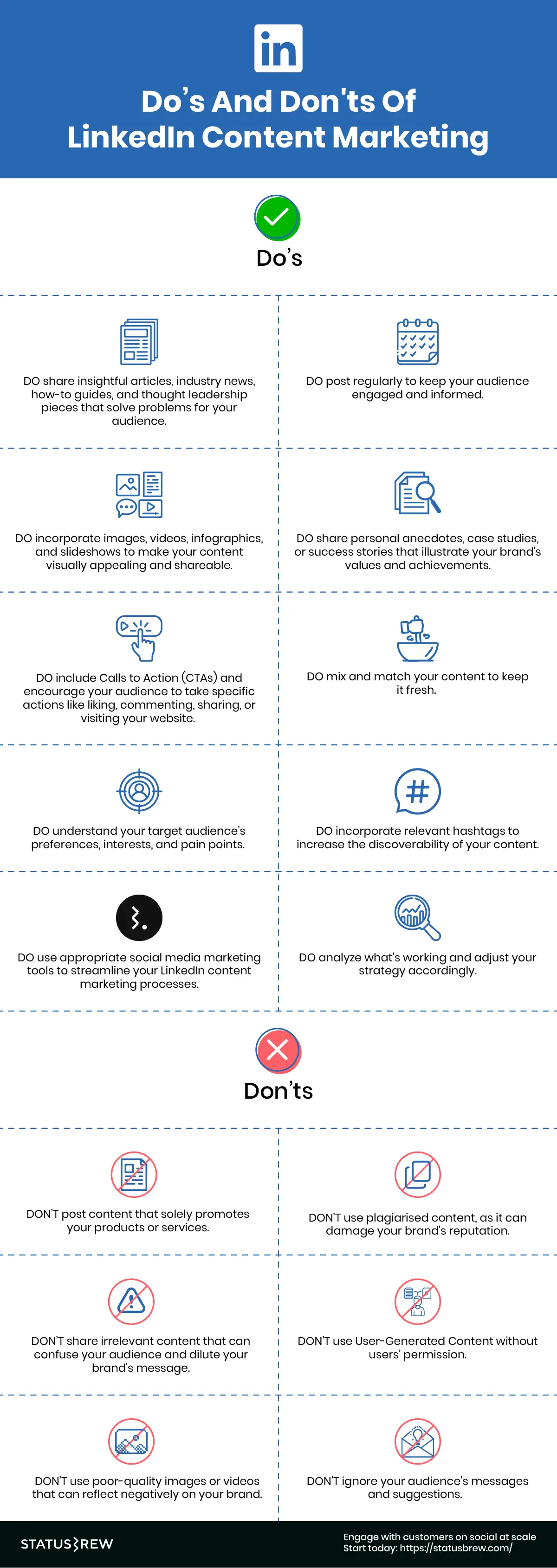
Ready To Maximize Your Content Marketing For LinkedIn?
Growing on LinkedIn doesn't happen overnight. This, for that matter, is true for any platform you are dealing with. But since we have discussed LinkedIn specifically, by now, you must know content marketing requires hard work, patience, and dedication throughout.
So, if you want to boost engagement on your LinkedIn Page, follow the best practices outlined above, along with examples, and you will surely see great results. As different businesses have different requirements, there is no one-size-fits-solution approach. But you can always take inspiration and craft a practice that might work wonders for your business. You just need to be updated and identify opportunities to help you build your brand, generate leads, and amplify your reach in the long run.
And while being at it, if you need assistance in your Linkedin Marketing journey, Statusbrew can assist you completely, be it engaging, monitoring, or scheduling.
Want to strategize your LinkedIn content marketing efforts with Statusbrew? Book a FREE demo to understand the know-how!


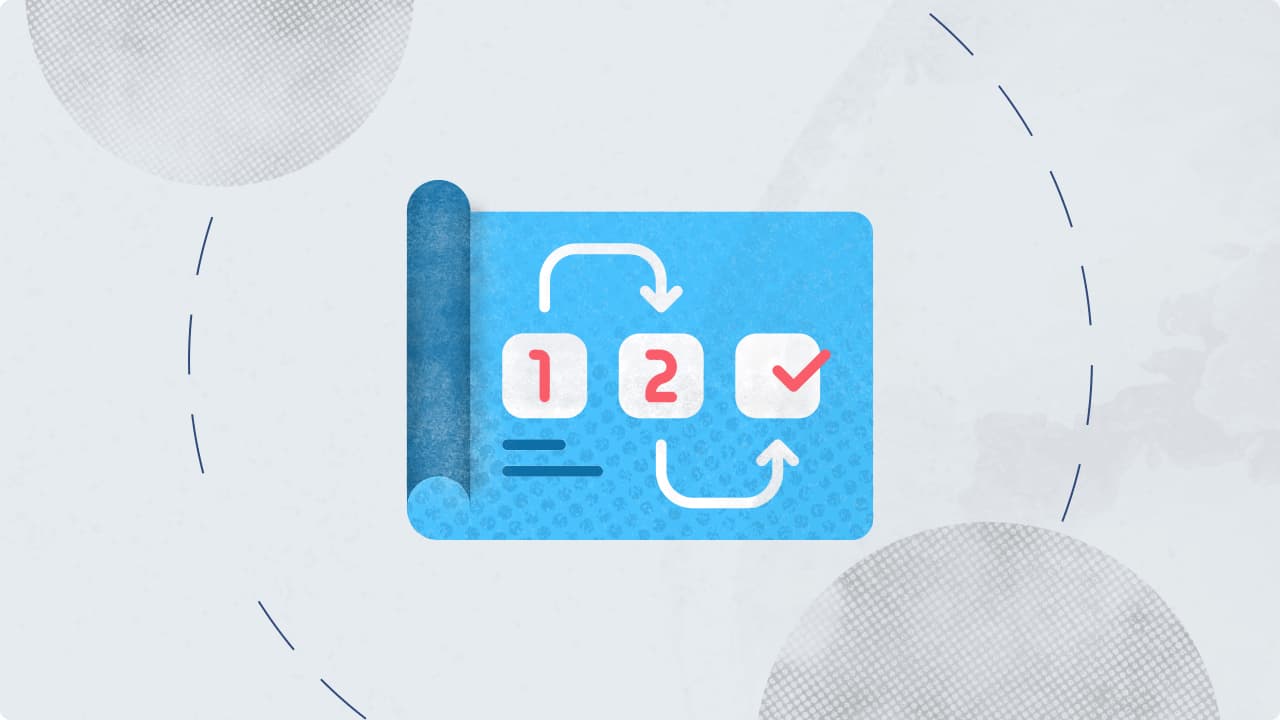

Explore the Statusbrew range of social media tools
Cancel anytime!